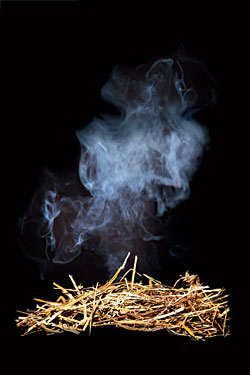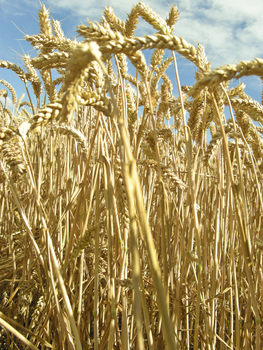For hundreds of years, cooks have prepared food using hay. One of it's first known attributes was efficiency-for hundreds of years people would prepare food by quickly bringing it to a boil and then placing it inside a sealed
haybox where it would then continue to cook without the need of any additional fuel.

But more important for today's cooks are the grassy and smoky flavors that can be attained by preparing food with hay. Using hay for flavor is nothing new-the French cooking term “dans le foin” means [cooked] in hay and has existed for decades (though it's often "conclure dans le foin," to go for a roll in the hay, though that really has nothing to do with cooking). There are typically two approaches to cooking with hay-using it for its smoke or directly infusing its flavor.
Smoking with hay is very popular at the moment. Teddy Diggs, at Ripple in Washington, serves hay-smoked goat cappellacci as well as a hay-smoked bluefish pate. Stefano Frigerio, of Washington’s Copper Pot Food Co., produces hay-smoked pheasant cappellacci. Smoking with hay must be done with care as it's a quick process and can become overly aggressive very quickly.
Rene Redzepi of Copenhagen’s Noma utilizes both approaches. He's created hay-smoked quail eggs served on a bed of smoking hay and a dessert called Strawberries and Straw, which features a hay-infused parfait.

But extracting straight flavor from hay is popular as well, even in the pastry kitchen. At Jean Georges in New York City, Johnny Iuzzini "has been known to churn hay ice cream." In Chicago, Grant Achatz serves a hay-infused creme brulee at his restaurant Alinea.
While working at a Vermont inn a few years ago, I had my first experience cooking with hay. We raised lamb on the property and wanted to highlight the grassy flavor inherent in our animals. We would sear off lamb shoulders and then wrap them in cheesecloth. In a large rondeau we'd then cover the bottom with hay and a small amount of mirepoix. The lamb shoulders would go in with about a half inch of hot water to keep the hay from burning while the shoulder roasted for hours.
The flavor was incredible-intense yet not overwhelming. I may have been rationalizing the matching of flavors, but it seemed to taste even more perfect as the lamb had been cooked in the same grasses from the same farm that they had been consuming while they were being raised. The inn was fairly upscale-4 Star & 4 Diamond-but this rustic preparation fit right in on the menu.